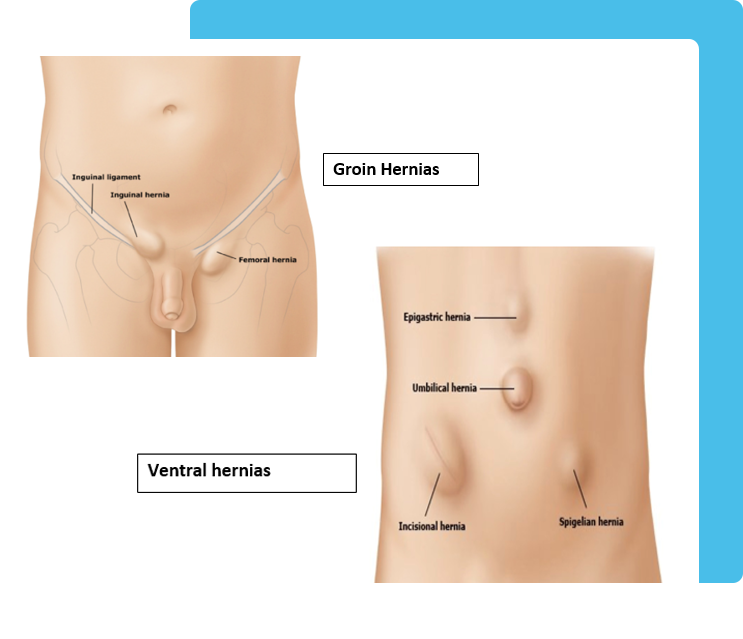
- Appointments
- Sunnybank 07 3344 1440
- Mater Health Hub 07 3041 5082
A hernia is a bulge that occurs through the muscles of the abdominal wall – it can be a bulging intestine or other organ, or even fat. Weakness in the muscle wall allows these bulges to push through.
Hernias are also more common in certain parts of the body where weak points exists namely in the groin and belly button area. They can also develop along scars lines due to incision from a previous operation.
In adults, the most common types of hernia are inguinal, Femoral, ventral and incisional. The other rare type of hernias are Lumbar , spigelian , obturator, etc.

Inguinal Hernia – Most common type of groin hernia, where a bulge appears in the groin above groin crease and can extend in to the scrotum due to a weak points in the abdominal wall where the spermatic cord courses through. They commonly affect men than women.
Femoral Hernia – less common than inguinal hernia and more commonly observed in elderly women. They develop below groin crease through femoral canal near major groin blood vessels to the thigh and leg.
Umbilical Hernia – Hernia occurs when part of the bowel or fatty tissue pushes through a weak spot in the abdominal wall, near the navel (belly button). They can contain part of intestine or fatty tissue and can be very small to very large in size. This can be present from birth or acquired as a result of straining the abdominal wall.
Epigastric hernia - Hernia comes through the midline fascia of abdominal wall between the umbilicus and the bottom end of the sternal bone. They are usually small and contain fatty tissue. However, they can be large and can contain large intestine
Incisional Hernia – occurs at the incision of previous surgery and results due to weak scar tissue
Hernias can be completely asymptomatic. Most patient have some symptoms like feeling lump, dragging sensation or pain. Occasionally they can be acutely painful due to a loop of intestine or tissue becomes trapped in this sac (Irreducible hernia), it can cause severe complications like bowel obstruction, ischemia or perforation of bowel (strangulated hernias) and requires immediate evaluation and treatment.
Hernias will not get better by themselves and often need surgical treatment to prevent the risk of strangulation (loss of blood supply to the entrapped herniated part). Most hernias can be treated either by open surgery or laparoscopic ( Key-hole) surgery provided patient is fit for operation. Surgery will fix the hernias and prevent from complications like obstruction or strangulation of bowels. The watchful waiting is usually not recommended but can be an option if have no symptoms or if patient is high anaesthetic risk.
Both techniques have long term similar outcome. Key hole surgery is associated with smaller incision and has been shown to reduce postoperative pain, shorter hospital stay and allow earlier return to work compared to open surgery. It is most suitable for patients with bilateral (both sides) groin hernias or recurrence from previous open surgery.
There is very strong evidence to suggest that tension free repair of the hernia defect using a surgical mesh reduces the risk of hernia recurrence. Most hernias in elective setting are repaired using synthetic hernia mesh is Australia.
Surgical mesh is a medical device made from Polypropylene or Nylon material. There are small pores in the mesh that allow the granulation tissue to grow and mesh acts as a scaffold for the scar tissue to form eventually leading to the incorporation of mesh in the scar tissue leading to a strong scar formation.
Recovery from hernia surgery is usually quick. Patient can be discharged same day or next day in most situations and are advised to avoid heavy lifting or strenuous physical activity for 4 to 6 weeks. The wound dressing can be removed after 5 to 7 days.
Umbilical , Paraumbilical, Epigastric , Incisional hernias are some of the ventral hernias. They can be small or very large. They can be repaired with open or key hole techniques.
Small hernias usually repaired by open surgery and most patients can be discharged home same day. Large ventral hernias and recurrent hernias may require advanced repair techniques of component separation and hence may prolong your hospital stay for few days.
All Copyrights © 2023 Dr. Kaushik Kumar
Powered by :: Growup Business Solution